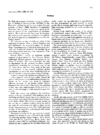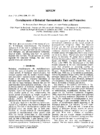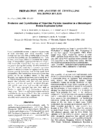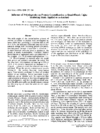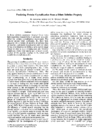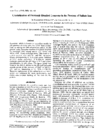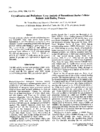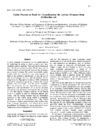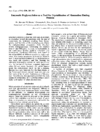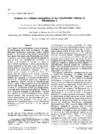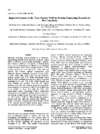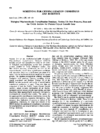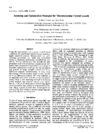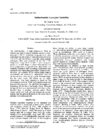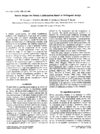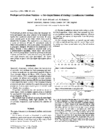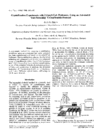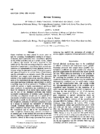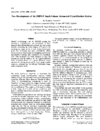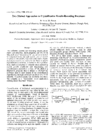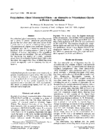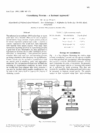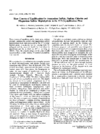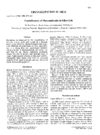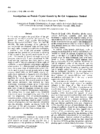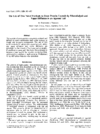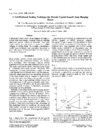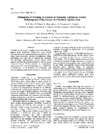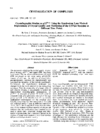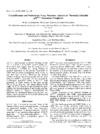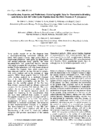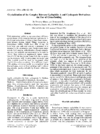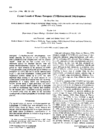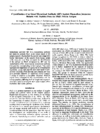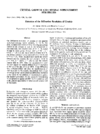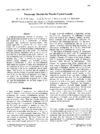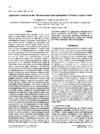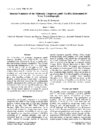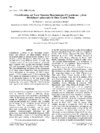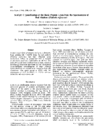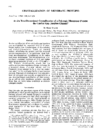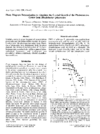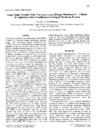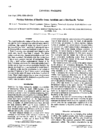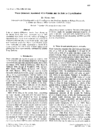issue contents
July 1994 issue

Cover illustration: The overall folding of the salmon trypsin molecule. Courtesy of A. O. Smalas and A Hordvik.
international union of crystallography
Free 

research papers
An overview is given of the science of crystals of biological macromolecules, from both biological and physical-chemical viewpoints. Perspectives for structural biology are presented.
Subunits of Flock House virus (FHV) (T = 3) and Nudaurelia capensis ω virus (T = 4) spontaneously assemble when their respective genes program a baculovirus expression system. Virus-like particles of FHV were crystallized and diffract X-rays to 3.3 Å resolution.
Light-scattering experiments show that α-amylase becomes monomeric and monodisperse near its solubility curve. Monodispersity seems to be a pre-requisite for growing good large crystals.
The osmotic second virial coefficient is proposed as a dilute solution property that predicts protein crystallization.
Lysozyme, previously desalted with ion-exchange resins. has been crystallized in the presence of sulfate ions. Sulfate interactions with lysozyme are analysed by mass spectrometry.
The crystallization of CRABPI (cellular retinoic acid-binding protein I) with two different ligands, retinoic acid and Am80 is described.
A fusion between lactose permease and cytochrome b562 was constructed with the goal of crystallizing the engineered protein. The fusion protein is red, has transport activity, is stable and is readily purified.
Methods for crystallinng glycoproteins by prior enzymatic removal of their carbohydrate chains are described. The results vary from protein to protein but the approach can lead to the preparation of high-quality crystals.
Quasi-elastic light scattering (QELS) was used to investigate quantitatively the mechanisms of nucleation, postnucleation growth, and dissolution in ensembles of both crystalline and amorphous aggregates of satellite tobacco mosaic virus (STMV), ferritin, apoferritin and pumpkin seed globulin.
Collisional quenching of the fluorescent molecule SPQ, light-scattering intensity measurements and calorimetry were used to investigate the interactions of solvent anions arid lysozyme in conditions of nucleation.
Early steps in the crystallization process of pancreatic ribonuclease have been investigated by time-dependent fluorescence anisotropy. The results were analysed by a maximum-entropy procedure that calculates a particle-size distribution.
Mirabilis anti-viral protein (MAP) is difficult to express in heterologous hosts such as Escherichia coli, while an MAP mutant Y72F expression vector with an OmpA leading sequence was constructed and expressed in E. coli. Crystals of Y72F were isomorphous with the wild-type crystals, but their imaging-plate photograph showed sharp intense spots without the streaking observed in the wild-type crystals.
The database and software query program allow access to macromolecular crystallization procedures and data for 2300 crystal forms.
A novel sparse-matrix screen, a panel of detergents, and a portfolio of electrostatic crosslinking agents are evaluated for macromolecular crystallization.
Solubility diagrams for the orthorhombic, or high-temperature. form of chicken egg-white lysozyme have been determined for 2-7%(w/v) NaCl, 298-313 K, pH 4.0-5.4 in 0.1 M sodium acetate buffer.
An approach to the problem of searching for protein crystallization conditions is described using common protein precipitants based on a class of matrices known as orthogonal arrays.
This rapid riethod of locating the boundary between conditions giving protein precipitation and those giving clear solution using microbatch trials often produces protein crystals, or information leading to them. Protein is added only to a minority of trials, using information gained from previous additions.
The hanging-drop method is used. 48 very different crystallization conditions have been screened. The required 48 different well solutiotis were prepared fully automatically.
By analyzing the solubility and by employing a limited number of precipitants in combination with additive search, the use of protein in crystallization screening can be significantly reduced. The method utilizes seeding.
A novel automated system is described for conducting rapid surveys of conditions for crystallization of macromolecules, applying niicrobatch or vapour-diffusion techniques. This system uses minimal quantities of reagents.
Two systems are described for electronically recording crystallization results. Both are Microsoft Excel programs, but one is a network system while the other is a `stand-alone' station.
Poly(ethylene) glycol monomethyl ether solutions have been used for the crystallization of some hydrophobic proteins. Crystals of lipase, endoglucanase 1 and a fragment of topoisomerase II have been obtained and the quality of the crystals of other proteins has also been improved.
A screening and strategy for crystallizing recombinant proteins is described. A number of examples with different proteins are presented.
Time courses of equilibration for three salts have been measured in the Z/3 crystallization plate. It is shown that by varying the diffusant and reservoir depth the time taken to equilibrate can change from 200 to 1400 h.
A silica hydrogel is evaluated during optimization of conditions for macromolecular crystal growth.
It is shown that the precipitating agents commonly used in protein crystal growth can be used in the gel acupuncture method. Silica and agar gels are recommended for this method. The results are illustrated for the growth of lysozyme, concanavalin A and ribonuclease.
The incorporation of agarose gels into liquid diffusion (microdialysis-gel) and vapor diffusion (sitting drop-gel) apparatus is described with lysozyme and canavalin as model proteins. Crystallization using gels has been demonstrated to improve crystal quality by reducing convective flow, sedimentation, nucleation and twinning.
Nucleation of lysozyme crystals is observed in free and gelled solutions. The case of a contaminated solution is studied as well.
A procedure is described which allows an investigator to supply a crystal with fresh mother material.
Elimination of twinning by growth in agarose gels is described.
The use of pure diastereomers of caged GTP leads to improvement of crystal quality for p21H−ras-caged GTP complexes. These have been used in conjunction with the Laue diffraction method to derive structures of the protein at time points during GTP hydrolysis.
PDB reference: 1gnp
p21H−ras has been crystallized with the weakly bound guanosine or GMP at the active site. Structural determination shows an unexpected peak in the electron density at the position normally occupied by the β-phosphate group in p21:GDP or p21:GTP complexes.
Small single crystals are reported of a complex between a 14-residue peptide fragment of HIV-1 Tat protein and a fragment of RNA (TAR) to which it binds. Small crystals of the RNA alone were also obtained.
Several Fabcyclic peptide complexes were obtained for an anti-malaria Fab 4B7 cleaved with elastase. The crystals are grown under similar conditions using PEG 8000, pH 5.5-7.5. but in four distinct crystal forms. Cross-seeding was used to obtain crystals of some of the complexes.
High diffraction-quality crystals of cyclosporin derivatives complexed with cyclophilin A containing only one complex per asymmetric unit have been grown using a cross-seeding technique.
High-resolution crystals of human 1-β-hydroxysteroid dehydrogenase were obtained with fully active enzyme preparation in the presence of βoctylglucoside, using a combined screening procedure. This is the first successful crystal growth of any human steroid-converting enzyme.
Crystals diffracting to about 5 Å have been obtained for an intact anti-malaria monoclonal antibody in complex with various peptides. The peptides are essential for the crystallization and influence the morphology of thc crystals.
Crystals of EF-Tu-Ts were converted from a low-resolution forni to a high-resolution one by the introduction of high molecular weight PEG's and a concomitant reduction in solvent content.
A computer-simulation method is proposed for studying the hydrodynamic interaction of rigid protein molecules.
Quantitative analysis of appropriately designed crystal growth experiments is shown to be a powerful way to characterize complex and interacting biochemical dependencies in macromolecular systems. Response surface experiments using `minimum predicted variance' designs and statistical fitting of quadratic models have been used to locate stationary points, in several dimensions, that simultaneously lead to better crystals and higher reproducibility.
The internal symmetries of molecular chaperone cpn60 (GroEL) have been investigated by X-ray crystallography and self-rotation function calculations. Cpn60 has one sevenfold symmetry axis and seven twofold axes perpendicular to the sevenfold axis. The molecular arrangement of cpn60 is discussed.
The three-dimensional structure of cytochrome c2 from the photosynthetic bacterium Rhodobacter sphaeroides has been determined by X-ray analyses of three crystal forms.
Growth steps. spiral dislocations and molecular packing has been observed on the surface of lysozyme crystals with an atomic force microscope.
Tetragorial lysozyme crystal growth rates are studied as a function of solution pH. Experiments using solution flow indicated unusual behavior of the crystal corners and in the (110) arid (101) face growth rates.
A new crystal form of red lysin was obtained as the result of screening acid pH crystallization conditions.
The crystallization of seed globulins from legumes is reviewed and new crystal forms are reported. Crystal contacts of narbonin are discussed with respect to the solubility properties of these proteins.
In situ two-dimensional crystallization of cardiac gap junction channels in their native membrane environment was accomplished by sequential detergent dialysis. Electron microscopy and image analysis revealed that the channels are formed by a hexameric cluster of protein subunits. This in situ approach may be useful for crystallizing other membrane proteins, especially those that are labile when solubilized as protein-detergent micelles.
By determination of a phase diagram, the process of crystal growth of a membrane protein was elucidated within a general physicochemical framework, and justification was provided to hitherto empirically selected crystallization conditions.
This paper explores the problem of crystallizing detergent complexes of integral membrane proteins and proposes a possible solution. Experiments based on these notions yielded large single crystals of the Neurospora plasma membrane H+-ATPase.
A site-specific variant of subtilisin is found to crystallize in two forms, sometimes in the same drop. The native enzyme is found to grow exclusively in only one of these forms. The second form, unique to the variant, grows much faster, which has been linked to increased flexibility in the variant enzyme.
Analysis of the crystal contacts of six crystal structures of protein kinase A has shown that the rotation of the upper domain by 15° observed for the binary complex is due to the intermolecular lattice forces and results in the opening of the cleft of the enzyme.
Water molecules occupy well determined sites inside or at the surface of biological macromolecules. On crystallization some of these waters are either desolvated or involved in crystal packing.


 journal menu
journal menu









